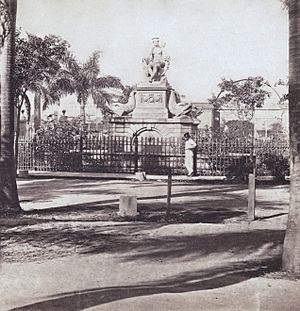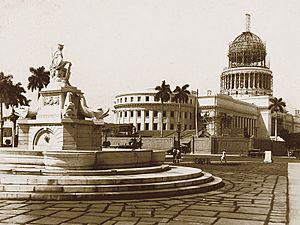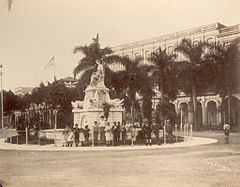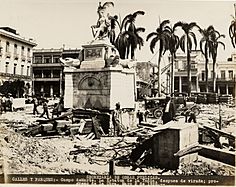Fuente de la India facts for kids
Quick facts for kids Fuente de la India |
|
|---|---|

Postcard of the fountain, circa 1900
|
|
| Artist | Giuseppe Gaggini |
| Year | 1837 inauguration |
| Medium | Carrara marble |
| Subject | Indigenous allegory of Havana |
| Dimensions | 300 cm × 600 cm (120 in × 240 in) |
| Condition | Not working |
| Location | |
The Fuente de la India (which means "Fountain of the Indian woman") is a famous fountain in Havana, Cuba. It was created by the artist Giuseppe Gaggini. You can find it at the very end of the Paseo del Prado, not far from El Capitolio.
This beautiful fountain features a statue of an Indian woman. She represents "Habana," the native name for the city of Havana. The fountain was first opened in 1837. It was a big event for the city, which was still quite new back then.
Over the years, the fountain has moved a few times. It was first outside the city walls. In 1863, it moved to Parque Central. Then, in 1875, it returned to its original spot. In 1928, it was turned to face the new Capitolio building.
History of the Fountain
The idea for the fountain came from Conde de Villanueva Don Claudio Martinez de Pinillos. It was made in Italy by the Italian sculptor Giuseppe Gaggini. The fountain arrived in Havana in 1837.
The statue of the Indian woman is about 3 meters (10 feet) tall. It is made of white Carrara marble. The statue stands on a rectangular base. There are four dolphins, one at each corner of the base. Water pours from their mouths into large shells below.
Details of the Statue
The young Indian woman sits on a rock. She looks towards the east, as if searching for something far away. Her face looks like an Indian woman's face. However, some people have pointed out that her profile looks more like a Greek woman. At the time, Greek features were seen as the most beautiful.
She wears a crown of feathers on her head. A holder for arrows, called a quiver, is on her left shoulder. In her right hand, she holds an oval shield. This shield has the original symbols of the city of Havana. In her left hand, she carries a cornucopia. This is a horn-shaped container that usually holds fruits. The artist filled it with Cuban fruits, and it has a pineapple on top.
The statue stands on a decorated base. This base has laurels and garlands. Four large dolphins support the base. Today, the fountain faces north. This means the face of the statue is always in shadow.
Gallery
See also
 In Spanish: Fuente de la India para niños
In Spanish: Fuente de la India para niños






